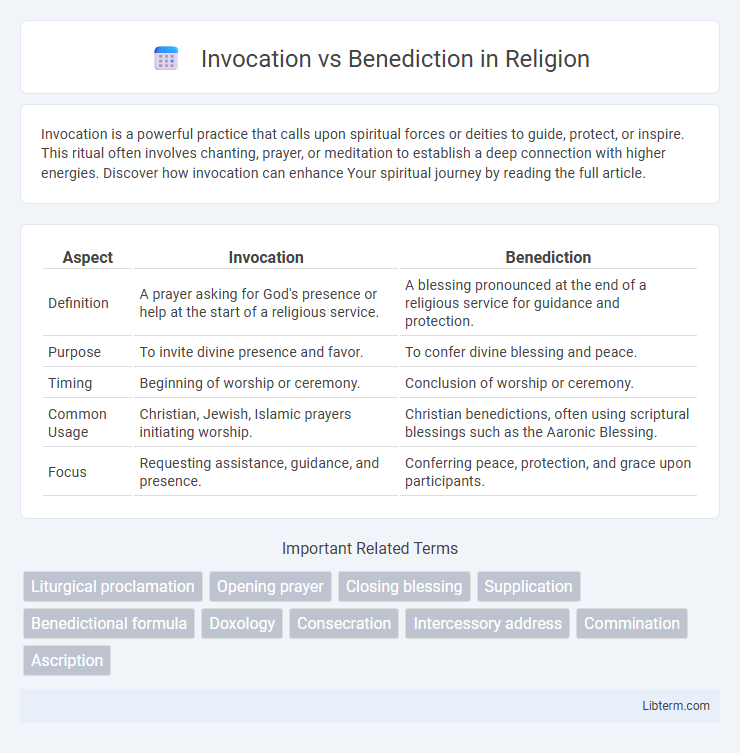Invocation is a powerful practice that calls upon spiritual forces or deities to guide, protect, or inspire. This ritual often involves chanting, prayer, or meditation to establish a deep connection with higher energies. Discover how invocation can enhance Your spiritual journey by reading the full article.
Table of Comparison
| Aspect | Invocation | Benediction |
|---|---|---|
| Definition | A prayer asking for God's presence or help at the start of a religious service. | A blessing pronounced at the end of a religious service for guidance and protection. |
| Purpose | To invite divine presence and favor. | To confer divine blessing and peace. |
| Timing | Beginning of worship or ceremony. | Conclusion of worship or ceremony. |
| Common Usage | Christian, Jewish, Islamic prayers initiating worship. | Christian benedictions, often using scriptural blessings such as the Aaronic Blessing. |
| Focus | Requesting assistance, guidance, and presence. | Conferring peace, protection, and grace upon participants. |
Understanding Invocation and Benediction
Invocation is a solemn prayer or appeal for divine presence and guidance, typically offered at the beginning of a religious service or ceremony. Benediction serves as a blessing pronounced at the conclusion of a worship service to invoke God's favor and protection upon the congregation. Both practices are integral to liturgical traditions, emphasizing spiritual connection and divine support at different stages of worship.
Historical Origins of Invocation and Benediction
Invocation and benediction both stem from ancient religious practices, with invocation originating in early polytheistic cultures where prayers sought divine presence and guidance before ceremonies. Benediction traces back to Judeo-Christian traditions, particularly within the Old Testament, where it served as a formal blessing pronounced by priests upon the people. Both forms have evolved into distinct liturgical elements, invocation as a call for spiritual aid and benediction as a concluding blessing.
Purpose of an Invocation
An invocation serves the purpose of calling upon a higher power, spirit, or divine presence to guide, bless, or inspire an event, ceremony, or gathering. It establishes a sacred atmosphere and invites spiritual assistance, often marking the formal beginning of religious services, meetings, or rituals. The primary goal of an invocation is to seek divine support and wisdom throughout the proceedings.
Purpose of a Benediction
A benediction serves the purpose of invoking divine blessing, protection, and favor upon a congregation or individual, often concluding religious ceremonies or gatherings with an expression of hope and peace. Unlike an invocation, which calls upon a deity at the beginning of an event to seek guidance or presence, a benediction offers a solemn and affirmative closure, emphasizing gratitude and spiritual empowerment. This ritual reinforces faith and community, fostering a sense of sacred unity and encouragement for the days ahead.
Key Differences between Invocation and Benediction
Invocation is a solemn prayer or request for divine presence and guidance at the beginning of a religious service, often seeking blessings and spiritual assistance. Benediction is a short blessing pronounced at the end of a worship service, aimed at imparting peace, protection, and grace to the congregation. The key difference lies in their timing and purpose: invocation initiates worship by inviting divine involvement, while benediction concludes it by offering a formal blessing.
Common Settings for Invocation and Benediction
Invocation commonly occurs at the beginning of religious services, meetings, or ceremonies, serving to invite divine presence and guidance. Benediction typically takes place at the conclusion of events such as worship services, weddings, or graduations, providing a solemn blessing or expression of goodwill. Both invocations and benedictions are integral in liturgical settings, framing communal gatherings with spiritual intent.
Structure and Elements of an Invocation
An invocation is a structured prayer or call for divine presence at the beginning of a ceremony or event, typically featuring elements such as an address to a deity, a request for guidance or blessing, and expressions of reverence or humility. Its format often includes an opening salutation, a petition for wisdom or support, and a closing that invites spiritual inspiration throughout the occasion. Unlike a benediction, which concludes an event with a blessing, the invocation establishes a sacred tone and framework for the proceedings.
Structure and Elements of a Benediction
A benediction typically follows a structured format consisting of an invocation of divine favor, a specific blessing, and a closing affirmation or amen. Common elements include addressing the deity, expressing wishes for protection, guidance, or peace, and concluding with a communal affirmation. This structure contrasts with an invocation, which primarily aims to call upon a deity or spirit at the beginning of a ceremony for presence and assistance.
Examples of Invocation and Benediction in Ceremonies
Invocation often begins religious ceremonies by calling upon a deity or divine presence for guidance and blessings, such as the opening prayer in a wedding or inauguration. Benediction typically concludes the event, offering a solemn blessing and farewell, like the priest's final blessing at a church service or the benediction at a graduation ceremony. Examples of invocation include the opening invocation at U.S. presidential inaugurations, while benedictions are common in Christian worship services and memorials.
Significance of Invocation and Benediction in Modern Events
Invocation and benediction hold crucial roles in modern events by framing the spiritual atmosphere through purposeful prayers or blessings. Invocation typically initiates gatherings by invoking divine presence for guidance and unity, fostering a respectful and focused environment. Benediction concludes occasions with expressions of goodwill and sanctity, leaving participants with a sense of closure and positive intention.
Invocation Infographic

 libterm.com
libterm.com